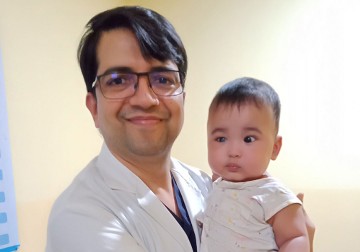A new study by Dr Muralidhar Ramappa and colleagues from the L V Prasad Eye Institute and others, discusses the surgical outcomes of selective corneal endothelial removal to manage Peters Anomaly. This novel, less-invasive approach is a major, new invention and an alternative to full-thickness corneal transplants in children.
‘Peters anomaly’ (PA) is a rare, congenital disorder that leads to corneal opacities at birth. If untreated, it can leave a child without vision for the rest of their life. PA typically affects the central posterior layers of the cornea, leading to various ‘zones’ of corneal opacities. The opacities on the cornea can present in many ways; sometimes, the iris and cornea adhere at various points, or the lens can fail to fully separate from the cornea during development. In people with PA, parts of the corneal endothelium—a monolayer cell barrier that maintains the cornea’s hydration and transparency—is abnormal leading to edema and corneal opacities.
Peters anomaly is the leading indication for a ‘full-thickness’ corneal transplant, a Penetrating Keratoplasty (PK). However, PK is a challenging and complex procedure which requires high-quality donor corneas. It often has modest, long-term success as it has many post-operative challenges. However, PK has been the only definitive strategy to visually rehabilitate these children. A previous review from LVPEI, among others, reported sub-optimal outcomes including 50-100% graft failures over time and other post-surgical complications. The weight of scientific evidence does not point to a full corneal graft, and yet, this rare condition has few alternative interventions.
A new paper by Dr Muralidhar Ramappa and others in the Cornea presents evidence for a novel surgical approach, Selective Endothelialectomy in Peters Anomaly (SEPA), as a viable alternative. In SEPA, only the abnormal region of the endothelium is selectively removed instead of a full transplant. The central idea of this approach is that once the abnormal layers are selectively removed, neighboring cells migrate or enlarge into the gap and restore visual function. The paper reviews the surgical outcomes of a large cohort: 34 eyes of 28 children who underwent SEPA (or its iterations: an optical iridectomy, SEPAO, or lensectomy, SEPAL) over eight years (2012-2019). 17 children (60.7%) were male, while a third had parental consanguinity.
29 eyes (85%) showed mild to moderate corneal clearing, indicating endothelial healing. Visual outcomes continue to improve in 32 eyes (94%) over time. 5 eyes with severe disease did not show improvement due to significant opacities or smaller corneas. Five masked, independent evaluators validated the diagnosis and the surgical outcomes behind these impressive results. The study is a key milestone in tackling PA-related congenital corneal opacities, as it presents a viable alternative to PK or other procedures.
‘Three separate studies, including an ongoing prospective study, have completed SEPA or its iterations in 120 children with Peters anomaly,’ says Dr Muralidhar Ramappa, Faculty Ophthalmologist, Child Sight Institute at LVPEI and SEPA’s inventor. ‘Our long-term experience has shown that SEPA is a safe, effective, and superior surgical alternative to full-thickness corneal transplantation in children with a broad spectrum of corneal opacities due to Peters anomaly. At LVPEI, we believe SEPA would benefit hundreds of children with PA-related corneal blindness worldwide.’
Citation
Ramappa, Muralidhar MBBS, MS; Chaurasia, Sunita MBBS, MS; Mohamed, Ashik MBBS, MTech, PhD, MAMS; Ramya Achanta, Divya Sree BS; Mandal, Anil Kumar MBBS, MD, DNB, FAMS; Edward, Deepak Paul MD, FACS, FARVO; Gokhale, Nikhil MBBS, MD, DNB; Swarup, Rishi MBBS, DOMS, FRCS; Nischal, Ken K. MD, FAAP, FRCOphth. Selective Endothelialectomy in Peters Anomaly: A Novel Surgical Technique and Its Clinical Outcomes in Children. Cornea: December 2022 - Volume 41 - Issue 12 - p 1477-1486 doi: 10.1097/ICO.0000000000003134
Photo credit: Dr Muralidhar Ramappa with one of his patients, by Muralidhar Ramappa.



